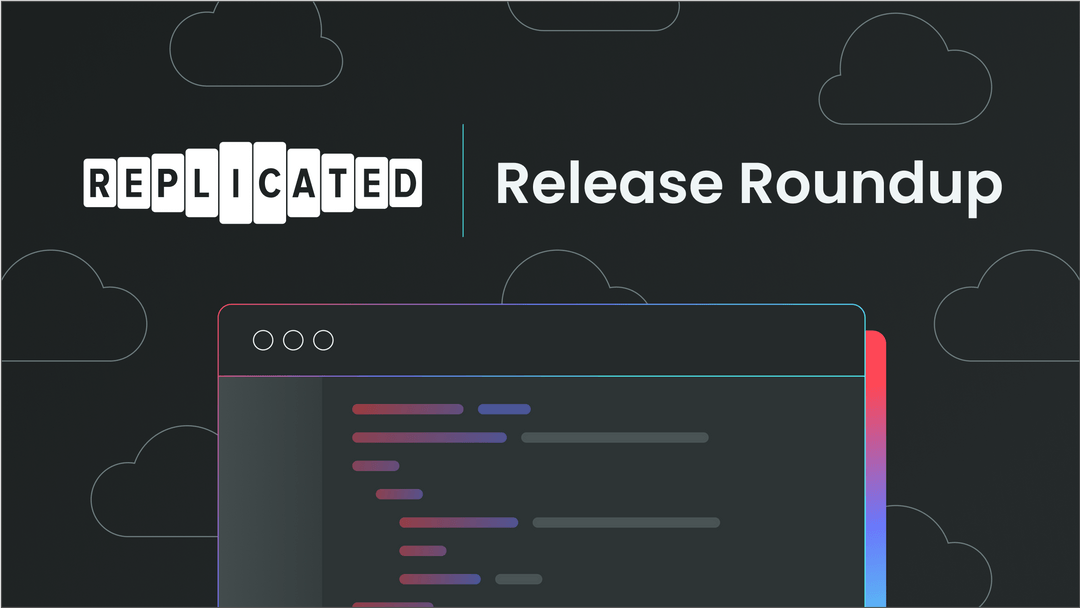
The summer heat is building and our Product & Engineering teams are bbqing up new features. It’s time for another fresh batch of exciting capabilities newly available in KOTS (our application manager), kURL (our installer), and the vendor portal. Check out the recently shipped features and release highlights for June 2023 below.
What’s New for The Vendor Portal:
Vendor Portal: Adoption Reporting
The new adoption report in the vendor portal helps you understand how users are adopting new versions of your software. This report will answer tactical questions like:
- Which of my customers are stuck on old versions? Which versions are they stuck on?
- How quickly are customers adopting new versions of my software?
- What is the distribution of software versions among my user base?
- How effective are our communication and marketing efforts for new releases?
- How is my release cadence impacting software adoption?
As well as strategic drivers like:
- Where are my biggest product adoption bottlenecks?
- Am I getting better or worse at improving these capabilities over time?

Check out the Adoption Reporting Blog Post and the demo below for more detail
What’s New for KOTS (Application Installer):
KOTS: Native Helm v2 Installation Mode Makes Installing Helm Charts in KOTS Even Better (Beta)
This new version of the native Helm installation method supports more Helm functionality, provides greater transparency and debuggability, and better matches vendors' expectations. Instead of modifying a vendor’s rendered Helm chart with kustomize, native Helm v2 uses Helm values to do things like rewrite image names and inject pull secrets. As a result, Helm installations can easily be reproduced and debugged outside of KOTS, Helm functionality like get values is supported, and there is less opportunity for bugs when KOTS installs Helm charts. Check out the docs for this new feature and watch the demo below:
KOTS: Orchestrate the Order in which KOTS Deploys Kubernetes Resources
If your application needs certain resources deployed and ready before other resources are deployed, you can now use new annotations to control ordering and readiness checks within KOTS. We added four new annotations: `kots.io/creation-phase`, `kots.io/deletion-phase`, `kots.io/wait-for-ready`, and `kots.io/wait-for-properties`. The phase annotations determine the order in which resources are created and deleted, and the wait annotations specify conditions that must be true before KOTS finishes deploying a resource and continues to the next. To use these new features check out the documentation and demo.
What’s New for kURL (Kubernetes Installer):
kURL: Configure Rook and Ceph on a Per-Node Basis (v2023.05.11-0)
Sometimes the hosts you want to make into an embedded cluster have different device names for the block storage. You can accommodate this with a new kURL configuration for rook that allows device names that vary between nodes. See the documentation here and an example configuration for inspiration for your own clusters.
kURL: Configure The Maximum Pods Per Node (v2023.05.08-0)
Certain use cases need lots of pods, for example some CI/CD workflows, if your use case is one of them you can now configure the maximum number of pods per node.
kURL: Support for Kubernetes 1.27 (v2023.05.08-0)
Support for Kubernetes 1.27 “Chill Vibes” has arrived! Upgrade your clusters and enjoy all of the new things that the latest version of kubernetes brings to the table. When upgrading to Kubernetes 1.27 be sure to also upgrade your KOTS to 1.100.0 or greater for compatibility.
kURL: Support for RHEL and Rocky Linux 9.2, Oracle Linux 8.8
kURL now supports all of these latest distribution releases. Find the latest compatibility updates here.
What’s New for Troubleshoot
Troubleshoot: Preflights Now Return Exit Codes Based on Success or Failure (Troubleshoot v0.63.0)
Now that preflights return non-zero exit codes under certain conditions, you can use this exit code to determine the path of scripts. For example, if the preflights fail the cli now returns an error code of 3 that indicates at least one preflight check has failed and you can halt the install process. Other return codes can indicate warnings were encountered or something about the command itself failed. This new feature can be especially useful when preflights are run in a container as a job to indicate that the preflight job failed. Read more about the exit codes here.
What’s New for replicated Documentation
replicated Documentation: New Docs on How to Automate App Installation with The KOTS CLI
You can now find information about how to automate the installation of an app in any kind of cluster: existing or embedded, and online or air gap. As part of these updates, we also added lots of additional context to clearly describe the prerequisites and the KOTS install flags required to install in each type of environment.
replicated Documentation: Updated Steps for How to Access the Admin Console After a Headless Installation
We added information about how to access the admin console if you are using the KOTS CLI in a VM that does not have a GUI-enabled OS. As this is a common use case, we updated the procedure to include a step for forwarding a port on a local machine to localhost:8800 on the VM. As part of this enhancement, to make this content easier to find, we also changed the heading to “Access the Admin Console” instead of “About Disabling the Port Forward”.
That’s it for the June release highlights! Want to learn more about these new features and what replicated does to help vendors and customers install and manage modern apps on-prem? We would love to show you -- click here to schedule a demo.